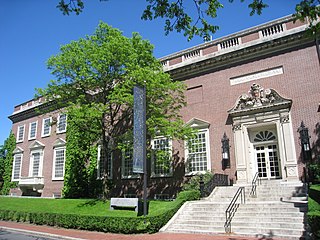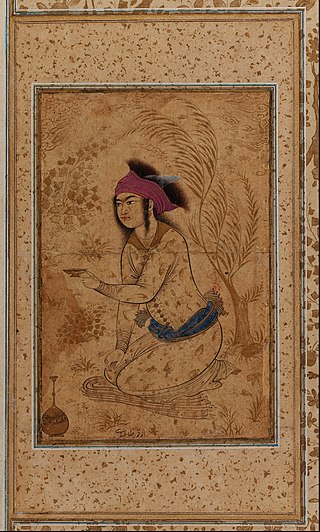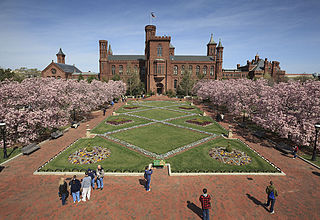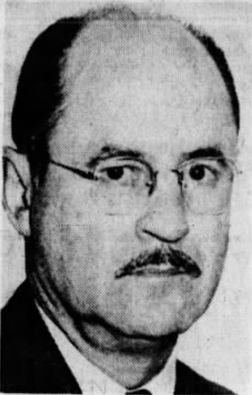
Mirza Shihab-ud-Din Muhammad Khurram, also known as Shah Jahan I, was the fifth emperor of the Mughal Empire, reigning from January 1628 until July 1658. Under his emperorship, the Mughals reached the peak of their architectural achievements and cultural glory.

The Smithsonian Institution, or simply the Smithsonian, is a group of museums, education and research centers, the largest such complex in the world, created by the U.S. government "for the increase and diffusion of knowledge". Founded on August 10, 1846, it operates as a trust instrumentality and is not formally a part of any of the three branches of the federal government. The institution is named after its founding donor, British scientist James Smithson. It was originally organized as the United States National Museum, but that name ceased to exist administratively in 1967.

The Arthur M. Sackler Gallery is an art museum of the Smithsonian Institution in Washington, D.C., focusing on Asian art. The Sackler Gallery and the Freer Gallery of Art together form the National Museum of Asian Art in the United States. The Freer and Sackler galleries house the largest Asian art research library in the country.

The Freer Gallery of Art is an art museum of the Smithsonian Institution in Washington, D.C. focusing on Asian art. The Freer and the Arthur M. Sackler Gallery together form the National Museum of Asian Art in the United States. The Freer and Sackler galleries house the largest Asian art research library in the country and contain art from East Asia, South Asia, Southeast Asia, the Islamic world, the ancient Near East, and ancient Egypt, as well as a significant collection of American art.

Arthur Mitchell Sackler was an American psychiatrist and marketer of pharmaceuticals whose fortune originated in medical advertising and trade publications. He was also a philanthropist and art collector. He was one of the three patriarchs of the controversial Sackler family pharmaceutical dynasty.

Masami Teraoka is an American contemporary artist. His work includes Ukiyo-e-influenced woodcut prints and paintings in watercolor and oil. He is known for work that merges traditional Edo-style aesthetics with icons of American culture.

The Harvard Art Museums are part of Harvard University and comprise three museums: the Fogg Museum, the Busch-Reisinger Museum, and the Arthur M. Sackler Museum, and four research centers: the Archaeological Exploration of Sardis, the Center for the Technical Study of Modern Art, the Harvard Art Museums Archives, and the Straus Center for Conservation and Technical Studies. The three museums that constitute the Harvard Art Museums were initially integrated into a single institution under the name Harvard University Art Museums in 1983. The word "University" was dropped from the institutional name in 2008.
Ebba Koch is an Austrian art and architectural historian, who defines and discusses cultural issues of interest to political, social and economic historians. Presently she is a professor at the Institute of Art History in Vienna, Austria and a senior researcher at the Austrian Academy of Sciences. She completed her doctorate in philosophy and her Habilitation at Vienna University.
Raghubir Singh (1942–1999) was an Indian photographer, most known for his landscapes and documentary-style photographs of the people of India. He was a self-taught photographer who worked in India and lived in Paris, London and New York. During his career he worked with National Geographic Magazine, The New York Times, The New Yorker and Time. In the early 1970s, he was one of the first photographers to reinvent the use of color at a time when color photography was still a marginal art form.

Abu'l-Hasan, from Delhi, India, was a Mughal painter of miniatures during the reign of Jahangir.

Glenn David Lowry is an American art historian and director of the Museum of Modern Art (MoMA) in New York City since 1995. His initiatives there include strengthening MoMA's contemporary art program, significantly developing the collection holdings in all media, and guiding two major campaigns for the renovation, expansion, and endowment of the museum. He has lectured and written extensively in support of contemporary art and artists and the role of museums in society, among other topics.

A Muraqqa is an album in book form containing Islamic miniature paintings and specimens of Islamic calligraphy, normally from several different sources, and perhaps other matter. The album was popular among collectors in the Islamic world, and by the later 16th century became the predominant format for miniature painting in the Persian Safavid, Mughal and Ottoman empires, greatly affecting the direction taken by the painting traditions of the Persian miniature, Ottoman miniature and Mughal miniature. The album largely replaced the full-scale illustrated manuscript of classics of Persian poetry, which had been the typical vehicle for the finest miniature painters up to that time. The great cost and delay of commissioning a top-quality example of such a work essentially restricted them to the ruler and a handful of other great figures, who usually had to maintain a whole workshop of calligraphers, artists and other craftsmen, with a librarian to manage the whole process.

Smithsonian Libraries and Archives is an institutional archives and library system comprising 21 branch libraries serving the various Smithsonian Institution museums and research centers. The Libraries and Archives serve Smithsonian Institution staff as well as the scholarly community and general public with information and reference support. Its collections number nearly 3 million volumes including 50,000 rare books and manuscripts.
J. Keith Wilson is an American Asian art curator. He is the Associate Director and curator of Ancient Chinese art at the Freer Gallery of Art and Arthur M. Sackler Gallery at the Smithsonian Institution in Washington, DC. Wilson is the former chief curator of Asian art at the Los Angeles County Museum of Art (LACMA).

The Smithsonian Gardens, a division of the Smithsonian Institution, is responsible for the "landscapes, interiorscapes, and horticulture-related collections and exhibits", which serve as an outdoor extension of the Smithsonian's museums and learning spaces in Washington, D.C. Established in 1972 as a groundskeeping and horticulture program, Smithsonian Gardens currently manages 180 acres of gardens on the National Mall, 64,000 square feet of greenhouse production space, and the Archives of American Gardens, a research collection of over 60,000 photographs and archival records covering American landscape history from the 1870s to the present.
Thomas "Tom" Woodward Lentz Jr. is an American art historian and curator. Lentz served as the Elizabeth and John Moors Cabot Director of the Harvard Art Museums from 2003 to 2015. He was the ninth director in its history.

Vidya Dehejia is a retired American academic and the Barbara Stoler Miller Professor Emerita of Indian and South Asian Art at Columbia University. She has published 24 books and numerous academic papers on the art of South Asia, and has curated many exhibitions on the same theme.
Conservation and restoration at the Smithsonian Institution deals with the care of the 138 million artifacts located in the collections of Smithsonian Institution. Work is conducted by one research center, the Museum Conservation Institute (MCI), and by conservators at the Smithsonian's museums, galleries, zoo. Smithsonian conservators provide myriad services to their units, including exhibit preparation of the museum collection and loan objects, advising on object care, training for future generations of conservationists, engaging in routine preventive care on a daily basis, conducting research projects related to the collections, and examining objects for evidence of manufacturing techniques and previous restorations All conservation labs collectively further the mission of the Smithsonian Institution, "the increase and diffusion of knowledge." Founded in 1846 the Smithsonian is the world's largest museum and research complex, consisting of 19 museums and galleries, the National Zoological Park, and nine research facilities.

Edgar Preston Richardson, also known as E. P. Richardson, was an American art historian, museum director, author, and curator. Richardson served as director of the Detroit Institute of Arts (1945–1962) and Winterthur Museum (1963–1966). He authored seven books, served on the boards of the Pennsylvania Academy of the Fine Arts (1966–1977) and other arts organizations, and co-founded the Archives of American Art at the Smithsonian in 1954.
Massumeh Farhad is an American curator, art historian, and author. She is the Chief Curator and Curator of Islamic Art at the Freer Gallery of Art and Arthur M. Sackler Gallery at the Smithsonian Institution National Museum of Asian Art. She is known for her work with Persian 17th-century manuscripts.













